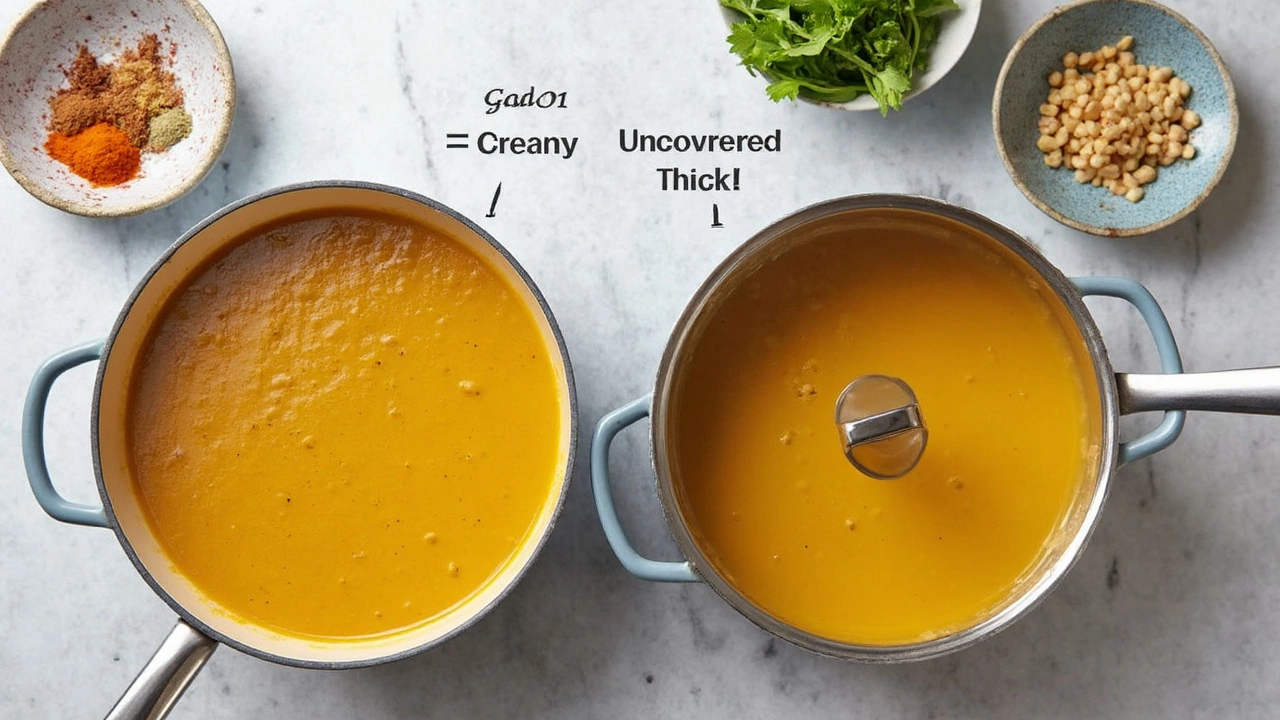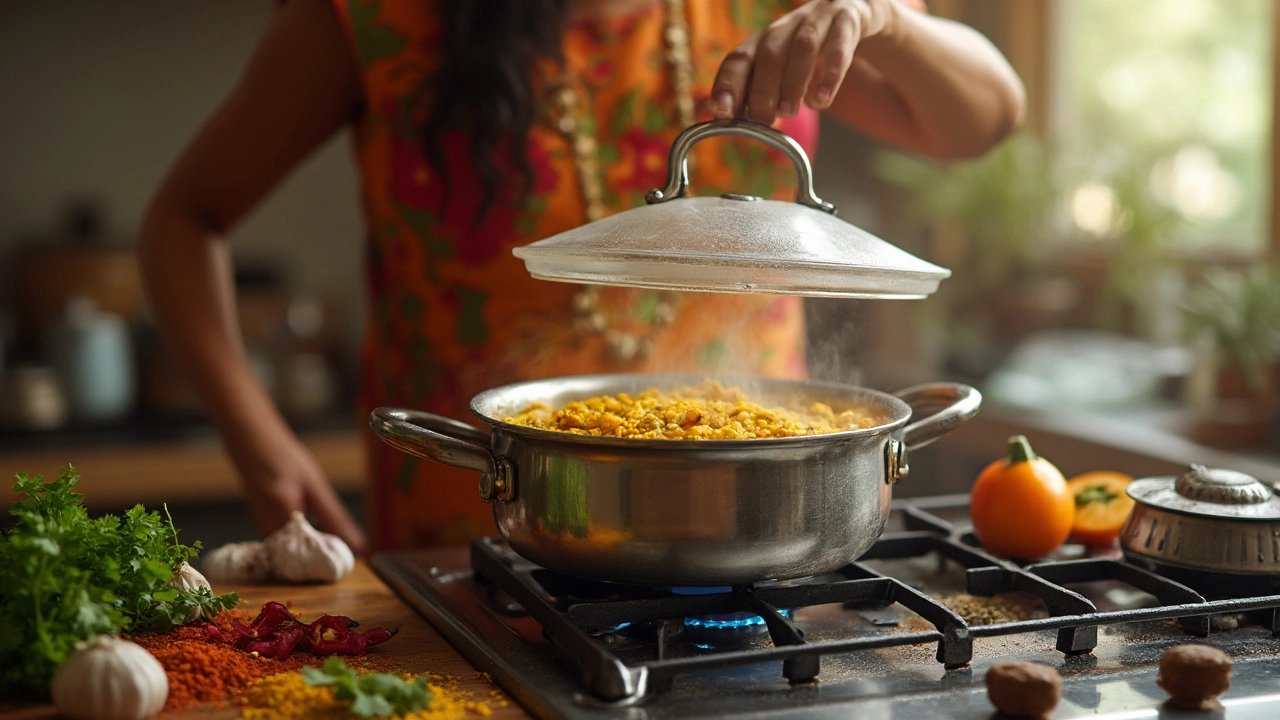If you’ve ever stood in your kitchen, ladle in hand, debating whether to slap a lid on your simmering pot of dal, you’re not alone. There’s a lot of mixed advice out there—your mom says one thing, your favorite YouTube chef says another, and that one cooking forum is a battlefield of strong opinions. So what actually happens if you cover dal, and when should you?
The short answer: it depends on what you want. Covering dal will cook it faster because the trapped steam heats everything up. This keeps the dal moist and softens it more evenly. But if you leave the lid off, some water evaporates, and you’ll get a thicker, creamier dal—great if you like a hearty, richer texture.
For thin, soupy dal, go ahead and cover it. If your goal is a thicker, chunkier consistency, keep it uncovered for at least part of the cooking time. If you’re rushed and want dinner ready quick, pop the lid on, but check often so it doesn’t boil over or go mushy. You can also do a combo: start covered, then finish uncovered to get rid of extra water and tweak your texture.
One tip lots of home cooks swear by—if your dal is foaming and threatening to bubble over, leave the lid slightly ajar. This controls the mess and lets a bit of steam escape. Just don’t wander off, or you might come back to a sticky stovetop surprise.
- Why people ask about covering dal
- The science behind covering or not covering
- How it changes texture and flavor
- Practical tips for the perfect pot
Why people ask about covering dal
This question comes up a lot because almost everyone has run into a pot of dal that turned out either way too thick or super watery—not what you pictured when you first started cooking. Since dal is a staple food for so many families, even tiny changes in the way it’s cooked can spark debate. Some folks swear by tradition and always cover the pot, while others go by feel or what their pressure cooker manual tells them.
The question also pops up because the dal cooking tips you get are all over the place. One cookbook will say cover tightly and simmer, while the next says leave it open for best results. Even among different types of dal—think masoor, toor, or chana—the advice can change. Plus, every region in South Asia has its own methods, often based on local climate, types of dal, and what mom or grandma used to do. No wonder everyone’s confused.
Some people also wonder about health and texture. Does covering trap nutrients? Does it make the dal too mushy, or does it help cook it more thoroughly? If you’re making a recipe for the first time or tweaking an old favorite, it’s pretty normal to search for the right approach.
| Cooking Style | Typical Result |
|---|---|
| Covered, Low Heat | Soft, moist, cooks faster |
| Uncovered, Medium Heat | Thickens as water evaporates |
| Start Covered, Finish Uncovered | Soft but thick, easy to adjust texture |
Bottom line—when you have so many ways to make something as simple as dal, the question of covering or not covering isn’t just a tiny detail. It’s a shortcut to getting the exact pot of dal you like on your table.
The science behind covering or not covering
You might think whether to cover your pot is just a minor detail, but in cooking, it actually shifts the way heat and moisture work on your dal. Here’s how it breaks down:
When you put the lid on, you’re trapping steam and heat. This does two things: raises the temperature inside the pot and locks in moisture. Lentils—whether they’re toor, moong, or masoor—swell better in this environment, especially if you start them with enough water. But the flip side is, you risk overcooking and getting that gluey, stuck-together texture if you leave it covered too long or set the heat too high.
Leaving the pot uncovered means liquid can escape as steam. This keeps the starch from your dal from turning everything into mush too quickly. Plus, if you want to check for salt, doneness, or skim off that foamy layer, it’s way easier.
Take a look at what actually happens in the pot:
| Method | Cooking Time | Water Loss | Texture |
|---|---|---|---|
| Covered | 20-30% faster | Minimal | Softer, mushy |
| Uncovered | Standard/slow | Moderate to high | Thicker, chunkier |
Ever notice that recipes for dal cooking tips often start covered and finish uncovered? That’s not a coincidence. It gives you control: soften the dal with the lid on, then let the extra water bubble away at the end for the right texture. This isn’t just tradition—it’s kitchen science. Also, old-school pressure cookers trap even more moisture, making dal even softer than a loose-lidded pot on the stove. If you want a more textured dal, don’t cover it the entire time.
Boiling covered can push foam up and cause spills, especially with high-protein dals like urad or chana. Skimming off the foam now and then (with the lid off) keeps things smooth and prevents a messy stovetop.

How it changes texture and flavor
Whether you cover your dal or not while cooking actually makes a noticeable difference. If you cook dal with a lid on, all that steam stays trapped in the pot. This means your dal comes out soft and mushy—a style that’s perfect for dishes like dal tadka or when you want that smooth, almost creamy soup. When you leave the pot uncovered, water evaporates faster. This concentrates the flavors and lets the dal thicken up naturally, so you end up with more texture and a heartier feel in every spoonful.
Check out this simple comparison to see the difference at a glance:
| Cooking Method | Texture | Flavor Profile |
|---|---|---|
| Covered | Smooth, softer, more blended | Lighter, less concentrated flavors |
| Uncovered | Thicker, chunkier, more textured | Deeper, richer, and more pronounced |
There’s a huge difference in what your kitchen smells like too. Keeping your dal uncovered lets more aroma waft through the air. If you like dialing up the flavors, let your dal finish cooking without a lid for the last 10-15 minutes. It also means spices and herbs added near the end get a chance to really show off, instead of steaming away into the lid’s condensation.
Want more control over your dal? Here are a few quick tips:
- For a dal recipe simple and creamy, keep the pot mostly covered, but crack it open near the end—this balances softness with just a little thickness.
- To keep lentils from splitting and going too mushy (think chana dal or toor dal), simmer with the lid partially off and check the consistency every 5-10 minutes.
- If you love thicker dal for scooping up with roti, finish the last stretch of cooking uncovered, letting the sauce naturally reduce.
While everyone has their own method, science backs this up: studies from food science journals show that covering slows down evaporation and keeps more water-soluble flavors in the pot, while open pots concentrate flavors and reduce liquid more quickly.
Practical tips for the perfect pot
Getting tasty dal is actually way easier when you follow a few tried-and-true tricks. It’s not just about whether you cover the pot or leave it open. Here’s the real deal for nailing your everyday dal, whether you like it thick, thin, or somewhere in the middle.
- dal cooking tips: Always rinse your dal really well before cooking. This keeps it from getting too foamy and helps with even cooking. Don’t just do a quick splash—really swish it around in the water until it runs mostly clear.
- If you want faster cooking, soak your dal for at least 30 minutes—an hour is even better. Lentils soak up water, soften up, and cook evenly. Plus, no one likes biting into a hard dal surprise!
- Start with more water than you think you need. Dal tends to soak up a lot, and you can always cook off extra later by leaving the lid off at the end.
- Keep an eye on the heat. If your pot is covered, use low to medium heat to avoid boiling over. Dal foams like crazy if it gets too bubbly, so don’t let it get wild.
- A pinch of turmeric and a tiny drizzle of oil right at the start can help stop frothing and also add a nice color and flavor boost.
- If you’re adding tomatoes or anything acidic, wait until the dal is mostly cooked. Acid can slow down the softening—your consistency won’t turn out right if you pour them in too early.
One last tip—a wide, heavy-bottomed pot works best for making dal. It spreads the heat evenly and gives you more control. Crowded, narrow pots lead to uneven mushy bits and chewy bits, which nobody wants.
Don’t stress over getting everything perfect on the first go. With a little practice and these tips, you’ll have a pot of dal that’s just right for your taste.
